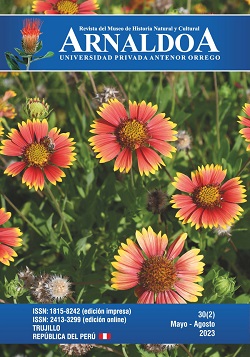Microscopic characters of the starchgranule of the species Phaseolus vulgarisand Phaseolus lunatus (Fabaceae)
DOI:
https://doi.org/10.22497/kws13a93Keywords:
Phaseolus vulgaris, bean, Phaseolus lunatus, pallar, starch grains, charactersAbstract
The main objective of the research is to identify the microscopic characters of the starch granule
of the species Phaseolus vulgaris “bean” and Phaseolus lunatus “pallar” (Fabaceae), such as the
shape, the hilum, the laminate, the fissure and the extinction cross. Eight seed samples were used,
eight varieties of beans, such as caballero, canario, black bean, garbancillo, ñuña type 1, ñuña type 2,
ñuña vaquita and panamito; in the same way two pallar, such as large pallar and baby pallar, which
were acquired in a local market. In each sample, one hundred starch grains were observed, and it
was possible to establish that the starch grains in both species share microscopic characteristics,
such as oval, reniform and elliptical shapes; the longitudinal centric fissure with lateral branches
and the extinction cross with curved, straight and wavy arms. However, it was not possible to
clearly differentiate at the species level, being linked up to the genus level. Various internal and
external factors in the plant influence the characters of the starch grain, for this reason it is proposed
to expand the sample and record the growth of the plant in order to establish some variations that
can be diagnosed when analyzing the starch grains of the plant. Each species.
Downloads
Downloads
Published
Issue
Section
License
Copyright (c) 2024 Denis E. Correa Trigoso, Mercedes E. Chaman Medina

This work is licensed under a Creative Commons Attribution 4.0 International License.
By submitting a paper to the journal, it is understood that the authors agree to transfer the publication rights to the journal once it is accepted.
It is permitted to share and adapt the contents of this journal in any medium or format always if the original source is properly cited and there are not commercial purposes.







